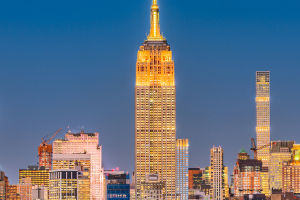Burj Khalifa, formerly known as Burj Dubai, stands tall and proud as an iconic symbol of human ingenuity and ambition. Referred to as the Dubai Tower or the Bis Dubai Tower, it holds the distinction of being the world's tallest building and artificial structure.
With its awe-inspiring height of 828 meters, a total of 162 floors, and a cost of $1.5 billion, the Burj Khalifa is a testament to the boundless potential of human creativity and engineering prowess.
The construction of the Burj Khalifa was a feat that required remarkable coordination and collaboration. Around 4,000 workers and 100 cranes were involved in the construction process.
Concrete was pumped vertically up over 606 meters, surpassing the previous record set by the Shanghai World Financial Center tower to reach such a spectacular height. The tower consumed 330,000 cubic meters of concrete, 62,000 tons of reinforced steel, and 142,000 square meters of glass, creating a structure that defies imagination.
The Burj Khalifa boasts a myriad of remarkable features that elevate its status as a modern marvel. Its 56 lifts can reach speeds of up to 17.4 meters per second, ensuring swift transportation within the building.
Notably, the tower features a double-decker observation lift capable of carrying up to 42 people at a time and provides breathtaking panoramic views.
The tower's functional design is equally impressive. The lower floors house the luxurious Armani hotel, while the 45th to 108th floors accommodate high-end apartments totaling 700 units. And the 78th floor boasts the world's highest swimming pool, offering residents a unique and exhilarating experience.
From the 108th to the 162nd floor, the Burj Khalifa serves as a bustling office complex. The 124th floor houses the world's highest observation deck, offering stunning vistas extending up to 80 kilometers, encompassing the distant landscapes.
Additionally, the tower houses the world's highest mosque on the 158th floor. To ensure an unrivaled 360° view, the Burj Khalifa's designers employed a brilliant "Y" shape design inspired by the delicate form of a butterfly orchid. This design merges the three wings of the building, creating a cohesive core structure that gracefully ascends toward the sky.
By avoiding the traditional geometric shape of skyscrapers, the Burj Khalifa minimizes internal dead corners and offers unobstructed views from every vantage point. The central core gradually transforms into a majestic minaret, breaking free from visual limitations and delivering an awe-inspiring visual spectacle.
The foundation of the Burj Khalifa showcases meticulous planning and engineering expertise. It rests on 125 piles with a diameter of 1.5 meters and a length of 50 meters, reinforced with 45,000 cubic meters of concrete. This robust foundation ensures the tower's stability and longevity.
Furthermore, the innovative Y-shaped design of the Burj Khalifa plays a pivotal role in combating the challenges posed by high-altitude winds. Its unique configuration enables the tower to rotate up to 120 degrees while the varying widths of each floor mitigate wind forces and enhance torsional resistance.
These design elements allow the Burj Khalifa to withstand the formidable forces of nature while maintaining its elegant stature.
The Burj Khalifa stands as a testament to human innovation, pushing the boundaries of architecture and engineering. Its extraordinary height, innovative design, and remarkable features have captured the world's imagination.


